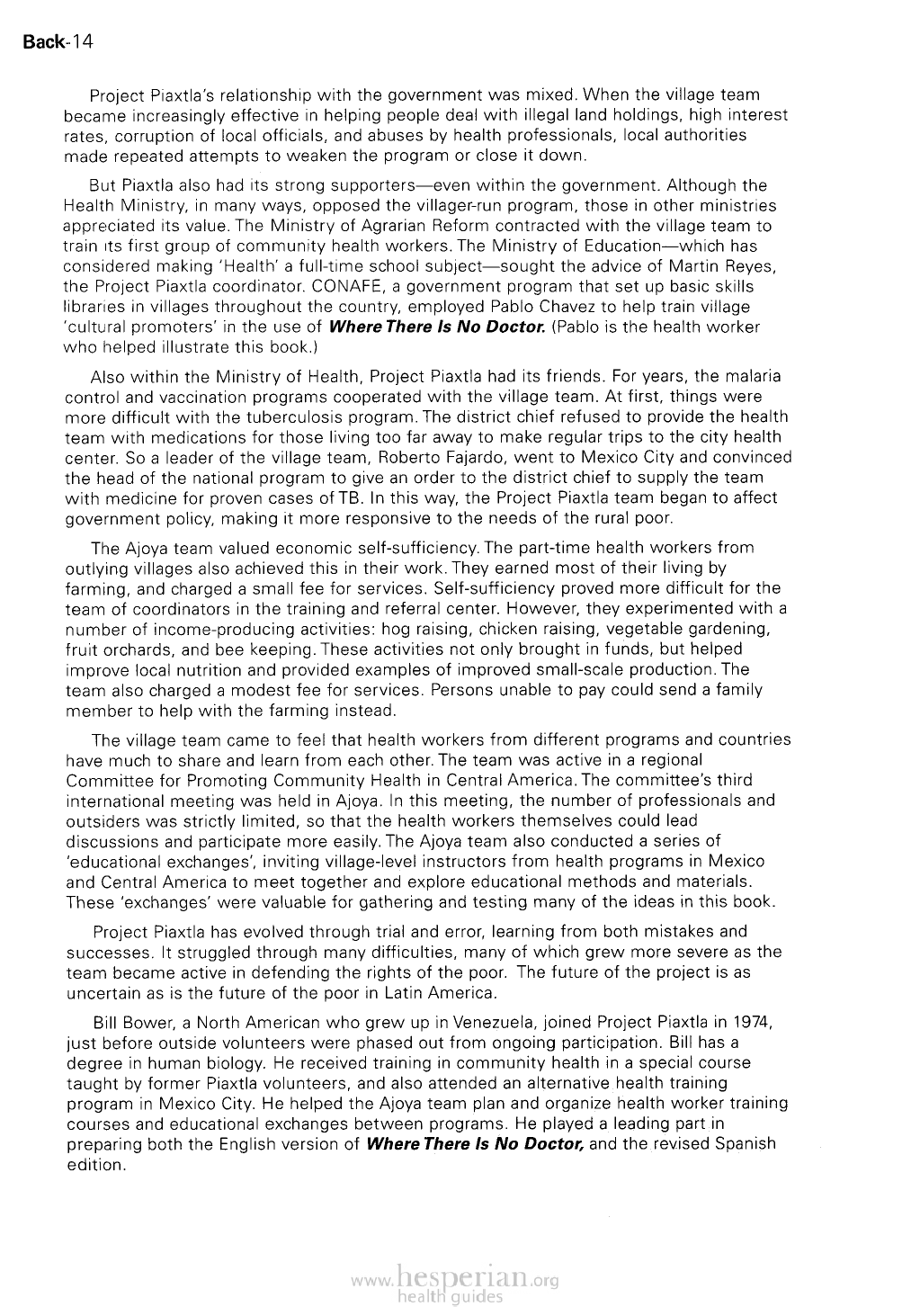
Back-14
Project Piaxtla’s relationship with the government was mixed. When the village team
became increasingly effective in helping people deal with illegal land holdings, high
interest rates, corruption of local officials, and abuses by health professionals, local
authorities made repeated attempts to weaken the program or close it down.
But Piaxtla also had its strong supporters—even within the government. Although the
Health Ministry, in many ways, opposed the villager-run program, those in other ministries
appreciated its value. The Ministry of Agrarian Reform contracted with the village team to
train its first group of community health workers. The Ministry of Education—which has
considered making ‘Health’ a full-time school subject—sought the advice of Martin Reyes,
the Project Piaxtla coordinator. CONAFE, a government program that set up basic skills
libraries in villages throughout the country, employed Pablo Chavez to help train village
‘cultural promoters’ in the use of WhereThere Is No Doctor. (Pablo is the health worker
who helped illustrate this book.)
Also within the Ministry of Health. Project Piaxtla had its friends. For years, the malaria
control and vaccination programs cooperated with the village team. At first, things were
more difficult with the tuberculosis program. The district chief refused to provide the
health team with medications for those living too far away to make regular trips to the city
health center. So a leader of the village team, Roberto Fajardo, went to Mexico City and
convinced the head of the national program to give an order to the district chief to supply
the team with medicine for proven cases of TB. In this way, the Project Piaxtla team began
to affect government policy, making it more responsive to the needs of the rural poor.
The Ajoya team valued economic self-sufficiency. The part-time health workers from
outlying villages also achieved this in their work. They earned most of their living by
farming, and charged a small fee for services. Self-sufficiency proved more difficult for the
team of coordinators in the training and referral center. However, they experimented with
a number of income-producing activities: hog raising, chicken raising, vegetable gardening,
fruit orchards, and bee keeping. These activities not only brought in funds, but helped
improve local nutrition and provided examples of improved small-scale production. The
team also charged a modest fee for services. Persons unable to pay could send a family
member to help with the farming instead.
The village team came to feel that health workers from different programs and countries
have much to share and learn from each other. The team was active in a regional
Committee for Promoting Community Health in Central America. The committee’s third
international meeting was held in Ajoya. In this meeting, the number of professionals
and outsiders was strictly limited, so that the health workers themselves could lead
discussions and participate more easily. The Ajoya team also conducted a series of
‘educational exchanges’, inviting village-level instructors from health programs in Mexico
and Central America to meet together and explore educational methods and materials.
These ‘exchanges’ were valuable for gathering and testing many of the ideas in this book.
Project Piaxtla has evolved through trial and error, learning from both mistakes and
successes. It struggled through many difficulties, many of which grew more severe as
the team became active in defending the rights of the poor. The future of the project is as
uncertain as is the future of the poor in Latin America.
Bill Bower, a North American who grew up in Venezuela, joined Project Piaxtla in 1974.
just before outside volunteers were phased out from ongoing participation. Bill has a
degree in human biology. He received training in community health in a special course
taught by former Piaxtla volunteers, and also attended an alternative health training
program in Mexico City. He helped the Ajoya team plan and organize health worker training
courses and educational exchanges between programs. He played a leading part in
preparing both the English version of WhereThere Is No Doctor, and the revised Spanish
edition.